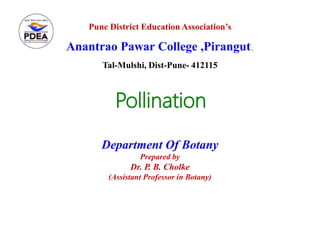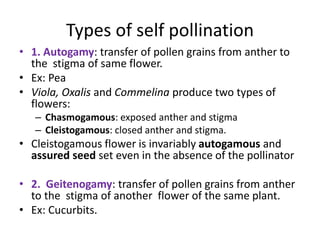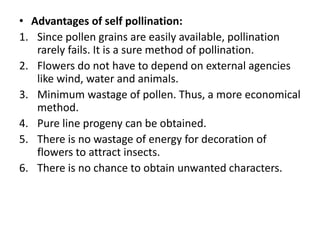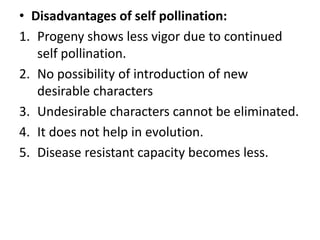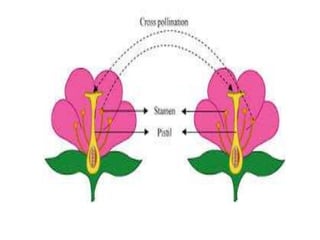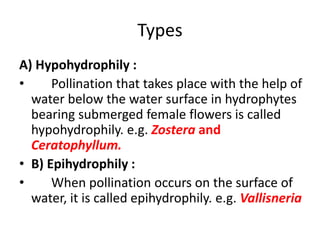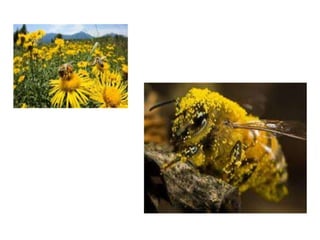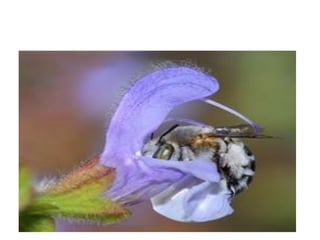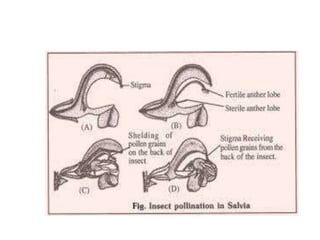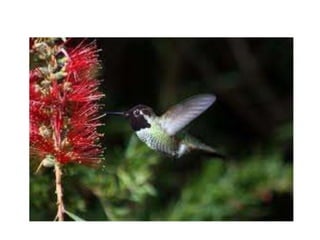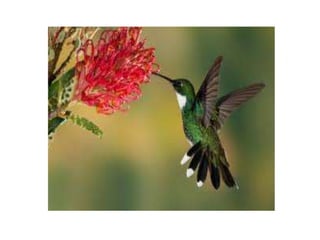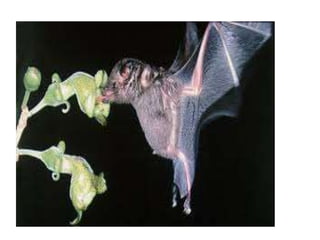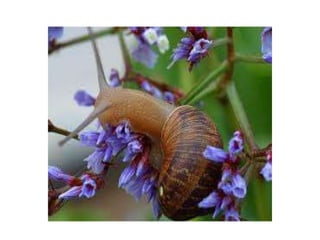Pollination
- 1. Pollination Department Of Botany Prepared by Dr. P. B. Cholke (Assistant Professor in Botany) Pune District Education Association’s Anantrao Pawar College ,Pirangut, Tal-Mulshi, Dist-Pune- 412115
- 2. Pollination Pollination is defined as the transfer of pollen grains from anther to the stigma.
- 5. Types of self pollination • 1. Autogamy: transfer of pollen grains from anther to the stigma of same flower. • Ex: Pea • Viola, Oxalis and Commelina produce two types of flowers: – Chasmogamous: exposed anther and stigma – Cleistogamous: closed anther and stigma. • Cleistogamous flower is invariably autogamous and assured seed set even in the absence of the pollinator • 2. Geitenogamy: transfer of pollen grains from anther to the stigma of another flower of the same plant. • Ex: Cucurbits.
- 6. Types of Cross pollination • 1. Xenogamy: it is the transfer of pollen grain from anther of a flower to the stigma of another flower produced on different plant belonging to same species. • Ex Papaya.
- 7. • 2. Hybridization: • it is the transfer of pollen grain from anther of a flower to the stigma of another flower produced on different plant belonging to different variety, sub species or Species. • Ex: Cotton
- 8. • Advantages of self pollination: 1. Since pollen grains are easily available, pollination rarely fails. It is a sure method of pollination. 2. Flowers do not have to depend on external agencies like wind, water and animals. 3. Minimum wastage of pollen. Thus, a more economical method. 4. Pure line progeny can be obtained. 5. There is no wastage of energy for decoration of flowers to attract insects. 6. There is no chance to obtain unwanted characters.
- 9. • Disadvantages of self pollination: 1. Progeny shows less vigor due to continued self pollination. 2. No possibility of introduction of new desirable characters 3. Undesirable characters cannot be eliminated. 4. It does not help in evolution. 5. Disease resistant capacity becomes less.
- 10. • Advantages of cross pollination: • Progeny shows enhanced vigor. • Offsprings are more viable and resistant. • There is a possibility to get new desirable characters. • Yield of crop can be maintained. • It helps in evolution. • Undesirable characters of the plant can be eliminated. •
- 11. • Disadvantages of cross pollination: • Pollination may fail due to distance barrier. • Flowers have to totally depend on the external agencies for pollination. • More wastage of pollen. • It may introduce some undesirable characters.
- 14. • Floral adaptations for anemophily : Pollination carried out by wind is called as anemophily. Flowers are small, numerous and inconspicuous Stamens possess long filaments and anthers are versatile Pollen grains are smooth, dry and light in weight. Flowers bear well exposed stamens so that they can be easily dispersed by wind currents. Pollen grains are produced in large numbers to compensate their wastage. To catch pollen grains, the stigmas become sticky, hairy, feathery or branched. Flowers are devoid of scent, nectar, etc. • e.g. Grasses, Maize, Jowar, Sugarcane, etc.
- 16. • Floral adaptations for hydrophily : Pollination carried out by water is called hydrophily. Flowers are small, inconspicuous and unisexual. Floral parts and pollen grains are unwettable, i.e. coated with mucilage. In plants with submerged female flowers, the pollen grains have specific gravity equal to or slightly greater than water. In plants with floating female flowers, the pollen- grains have specific gravity less than that of water. • Stigma is long and sticky. • Scent, colour and nectar absent in flowers. • e.g. Vallisneria, Ceratophyllum
- 17. Types A) Hypohydrophily : • Pollination that takes place with the help of water below the water surface in hydrophytes bearing submerged female flowers is called hypohydrophily. e.g. Zostera and Ceratophyllum. • B) Epihydrophily : • When pollination occurs on the surface of water, it is called epihydrophily. e.g. Vallisneria
- 18. • In Vallisneria, epihydrophily type of pollination takes place. • Vallisneria is a dioecious plant (male and female flowers are produced on different plants) and flowers are submerged. • At the time of maturity, the male flowers are detached from the male inflorescence and begin to float on water surface. • The female flowers have coiled, long pedicel which undergoes uncoiling at the time of maturity and reaches the water surface. • The male flowers surround the female flower and undergo anthesis due to which pollen grains are deposited on the stigma of female flower and cross pollination is achieved.
- 20. Floating male flowers Coiled stalk of female flower Fig. Hydrophily e.g. Vallisneria
- 21. • Floral adaptations for entomophlly : Pollination carried out by insects is called as entomophily (bees are most common agents). Flowers are large and attractive. Flowers have attractive bright colors, with pleasant fragrance and nectar gland. In some plants, additional modifications are made to attract insects. e.g. Corona in passion flower and petalloid bracts in Bougainvillea. Pollen grains possess spiny or rough outer wall. Stigma has rough and sticky surface.
- 22. • To favour insect pollination, some plants develop special mechanism e.g. liver mechanism in Salvia. • e.g. Jasmine, Rose, Salvia, Bougainvillea.
- 24. lever-mechanism or turn-pipe mechanism In Salvia. i) In Salvia, flower is bisexual and protandrous, i.e. anthers mature earlier than stigma. ii) The two stamens of flower have long bifurcated connective. iii)Upper branch of connective bears fertile anther lobe, while lower has sterile anther lobe. iv)When an insect enters the flower, it pushes the lower sterile lobes. As a result, the upper fertile anther lobe bends down. v) The fertile anther lobe comes in contact with back side of insect body and pollen grains are dusted there. vi)When the same insect visits another flower with matured gynoecium, the pollen grains are picked up by the receptive stigma. vii) This mechanism is called lever-mechanism or turn-pipe mechanism.
- 27. • Floral adaptations for ornithophily : Pollination carried out by birds is called ornithophily. Flowers are large with thick and fleshy floral parts. Corolla is tubular or funnel shaped. Flowers are with bright colours for attracting the birds. Flowers lack fragrance as birds have poor sense of smell. Pollen grains are sticky. Large amount of sugary nectar produced by the flower is used as drink by the birds. • e.g. Callistemon (bottle brush), Bignonia, Butea and Bombax (silk cotton). • The commonly pollinating birds are: crow, bulbul, sunbirds and humming birds.
- 32. • Floral adaptations for Chiropterophily : • a) Pollination takes place with the help of bats. • b) Flowers are large, stout enough so that bats can hold on to the flowers. • c) Chiropterophilous plants are nocturnal, i.e. open their flowers during night time. • d) Flowers emit rotten fruits like fermenting fruity odour. • e) Flowers have large number of stamens to produce a considerably large quantity of pollen grains. • e.g. Anthocephallus (Kadamb), Adansonia (Baobab tree), Bauhinia

